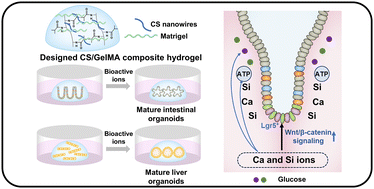A bioactive calcium silicate nanowire-containing hydrogel for organoid formation and functionalization†
Abstract
Organoids, which are 3D multicellular constructs, have garnered significant attention in recent years. Existing organoid culture methods predominantly utilize natural and synthetic polymeric hydrogels. This study explored the potential of a composite hydrogel mainly consisting of calcium silicate (CS) nanowires and methacrylated gelatin (GelMA) as a substrate for organoid formation and functionalization, specifically for intestinal and liver organoids. Furthermore, the research delved into the mechanisms by which CS nanowires promote the structure formation and development of organoids. It was discovered that CS nanowires can influence the stiffness of the hydrogel, thereby regulating the expression of the mechanosensory factor yes-associated protein (YAP). Additionally, the bioactive ions released by CS nanowires in the culture medium could accelerate Wnt/β-catenin signaling, further stimulating organoid development. Moreover, bioactive ions were found to enhance the nutrient absorption and ATP metabolic activity of intestinal organoids. Overall, the CS/GelMA composite hydrogel proves to be a promising substrate for organoid formation and development. This research suggested that inorganic biomaterials hold significant potential in organoid research, offering bioactivities, biosafety, and cost-effectiveness.



 Please wait while we load your content...
Please wait while we load your content...